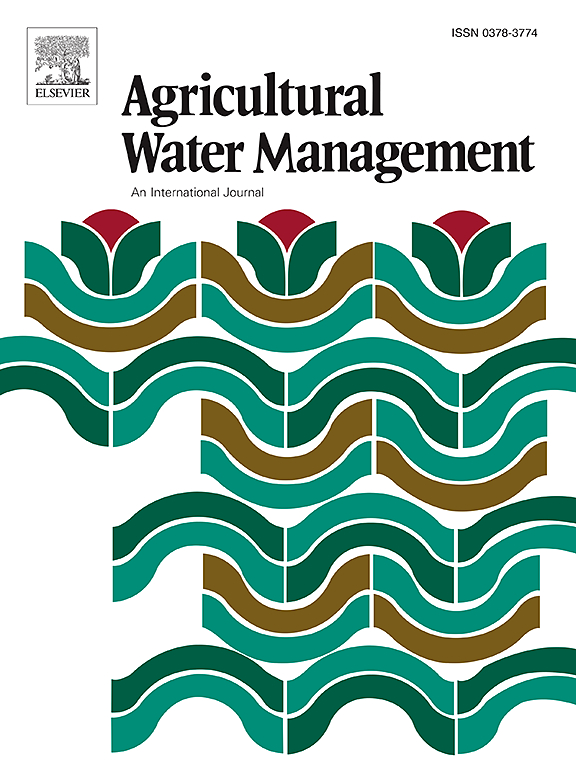Integrating multi-source remote sensing and machine learning for root-zone soil moisture and yield prediction of winter oilseed rape (Brassica napus L.): A new perspective from the temperature-vegetation index feature space
IF 5.9
1区 农林科学
Q1 AGRONOMY
引用次数: 0
Abstract
Accurately assessing root-zone soil moisture is crucial for precision irrigation, as it directly influences crop yield. The Temperature-Vegetation Index (Ts-VI) Feature Space, which combines land surface temperature (Ts) and vegetation index (VI), is widely used to evaluate root-zone soil moisture in vegetated areas. However, its effectiveness in estimating crop yield remains unclear. Therefore, the objectives of this study are: (1) to collect multispectral and thermal infrared remote sensing data from a two-year (2021–2023) field experiment on winter oilseed rape (Brassica napus L.), and to optimize and evaluate the fitting methods of the dry and wet edges of the Ts-VI feature space based on the selected vegetation indices; (2) to analyze the spatiotemporal patterns of the Temperature Vegetation Dryness Index (TVDI) derived from the optimized Ts-VI feature space and estimate root-zone soil moisture (SM) and crop yield; and (3) to precisely invert the SM and yield of winter oilseed rape in the 0–60 cm root-zone using three machine learning algorithms—Support Vector Regression (SVR), Extreme Gradient Boosting Regression (XGBR), and Random Forest Regression (RFR)—based on the optimized TVDI. Results indicate that, among the various fitting methods, the polynomial fitting method shows the best performance. The performance of the root-zone soil moisture prediction models across different growth stages follows the order of budding stage > seedling stage > flowering stage, and with the increase of soil depth, the performance of the model gradually deteriorates.In the yield inversion of winter oilseed rape, TVDI effectively predicts yield, with the coefficient of determination (R2) ranging from 0.430 to 0.480 and RMSE ranging from 213.399 to 267.212 kg ha−1 during the seedling stage, R2 ranging from 0.640 to 0.747 and RMSE ranging from 110.712 to 178.133 kg ha−1 during the budding stage, and R2 ranging from 0.680 to 0.773 and RMSE ranging from 83.815 to 147.301 kg ha−1 during the flowering stage. The flowering stage effectively reflects crop yield trends and allows for accurate yield prediction of winter oilseed rape up to two months in advance. A comparison of the modeling results from XGBR, SVR, and RFR shows that XGBR provides the best fit for both root-zone soil moisture and yield predictions. Compared to linear regression models, the three machine learning models significantly improve accuracy and fit, providing more precise evaluations of root-zone soil moisture and yield. In addition, through the comparison and verification of this method in other regions, it shows that the results also have certain reference value. The combination of the Ts-VI feature space and machine learning algorithms not only enables precise monitoring of root-zone soil moisture conditions but also predicts future crop yield trends, offering valuable insights for water resource management and irrigation decision-making in precision agriculture.
整合多源遥感和机器学习,用于冬油菜根区土壤水分和产量预测:温度-植被指数特征空间的新视角
准确评估根区土壤湿度对精准灌溉至关重要,因为它直接影响作物产量。温度-植被指数(Ts-VI)特征空间结合了地表温度(Ts)和植被指数(VI),被广泛用于评估植被区根区土壤湿度。然而,它在估算作物产量方面的有效性仍不明确。因此,本研究的目标是(1) 收集为期两年(2021-2023 年)的冬油菜(Brassica napus L. )田间试验的多光谱和热红外遥感数据,优化和评估植被指数对作物产量的影响。(2) 分析由优化后的 Ts-VI 特征空间导出的温度植被干燥指数(TVDI)的时空变化规律,并估算根区土壤水分(SM)和作物产量;(3) 基于优化的 TVDI,使用三种机器学习算法--支持向量回归(SVR)、极端梯度提升回归(XGBR)和随机森林回归(RFR)--精确反演 0-60 厘米根区土壤湿度和冬油菜产量。结果表明,在各种拟合方法中,多项式拟合方法的性能最佳。根区土壤水分预测模型在不同生长阶段的表现依次为萌芽期> 苗期> 花期,随着土壤深度的增加,模型的表现逐渐变差。在冬油菜产量反演中,TVDI能有效预测产量,其判定系数(R2)从0.在冬油菜产量反演中,TVDI 有效地预测了产量,苗期的判定系数(R2)为 0.430 至 0.480,有效差异系数(RMSE)为 213.399 至 267.212 千克/公顷;蕾期的判定系数(R2)为 0.640 至 0.747,有效差异系数(RMSE)为 110.712 至 178.133 千克/公顷;花期的判定系数(R2)为 0.680 至 0.773,有效差异系数(RMSE)为 83.815 至 147.301 千克/公顷。开花期能有效反映作物产量趋势,可提前两个月对冬油菜进行准确的产量预测。对 XGBR、SVR 和 RFR 的建模结果进行比较后发现,XGBR 对根区土壤水分和产量预测的拟合效果最好。与线性回归模型相比,这三种机器学习模型大大提高了准确性和拟合度,为根区土壤水分和产量提供了更精确的评估。此外,通过该方法在其他地区的对比验证,表明其结果也具有一定的参考价值。Ts-VI特征空间与机器学习算法的结合,不仅能精确监测根区土壤水分状况,还能预测未来作物产量趋势,为精准农业中的水资源管理和灌溉决策提供有价值的见解。
本文章由计算机程序翻译,如有差异,请以英文原文为准。
求助全文
约1分钟内获得全文
求助全文
来源期刊

Agricultural Water Management
农林科学-农艺学
CiteScore
12.10
自引率
14.90%
发文量
648
审稿时长
4.9 months
期刊介绍:
Agricultural Water Management publishes papers of international significance relating to the science, economics, and policy of agricultural water management. In all cases, manuscripts must address implications and provide insight regarding agricultural water management.
 求助内容:
求助内容: 应助结果提醒方式:
应助结果提醒方式:


